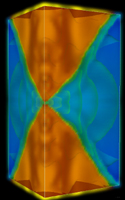
Zoom Figure
Click on the image for larger viewScientists are simulating how the very first stars in our universe were born. This diagram shows a still from one such simulation. The cube on the right is a blown up region at the center of the box on the left.
The stars we see today formed out of collapsing clouds of gas and dust. In the very early universe, however, the stars had fewer ingredients available. There wasn't any dust yet, or heavy elements, both of which help cool the gas in a cloud so that it can collapse. Instead, the very first stars formed from nothing but hydrogen and helium gas. Astronomers theorize that, in order to overcome their lack of cooling ingredients, these stars would have needed more mass to form. The first stars were thought to have been more massive than even the most massive stars observed today.
At the very center of each box shown here is the forming star -- the star itself is too small to see at this scale. The red areas show hot gas with temperatures as high as 50,000 Kelvin (90,000 degrees Fahrenheit), heated by, and surrounding, the forming star. Blue shows much cooler gas, with the darkest blue showing the densest portions of cool gas, shaped like a disk surrounding the seedling star.
As the star pulls matter from the disk onto it, it grows more massive. Meanwhile, some gas -- shown in the red areas -- is so hot that it expands and escapes. Eventually, large amounts of the surrounding gas become too hot and escape. At this point, the star stops growing -- it has finished "baking."
Scientists at NASA's Jet Propulsion Laboratory, Pasadena, Calif., have used these simulations to show that the first stars, during their formation, had a greater impact on surrounding gas than previously thought. The higher gas temperatures would have caused the stars to stop growing sooner. As a result, the first stars were not likely hundreds of times the mass of sun, but only tens of times its mass.
None of these first stars still exist today. After a few million years they exploded in fiery supernovae, spewing heavier elements cooked in their interiors out into the surrounding gas.
For technical details and videos visit http://www-tap.scphys.kyoto-u.ac.jp/~hosokawa/firststarstop_e.html.

